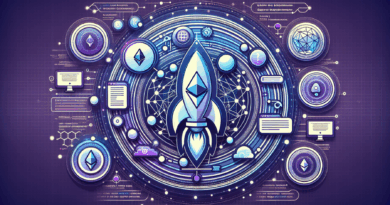What Is Ethereum? A Comprehensive Guide to the World’s Largest Blockchain Ecosystem
In the ever-evolving landscape of blockchain technology, Ethereum stands out as a transformative force that transcends the boundaries of traditional cryptocurrencies. Since its inception in 2014 by Vitalik Buterin, this decentralized platform has revolutionized how we perceive and utilize blockchain, giving birth to a vast ecosystem of applications, financial innovations, and technological advancements. But what exactly is Ethereum, and why has it become a cornerstone of the digital economy? Let’s dive into its core principles, groundbreaking features, and real-world impacts.
The Genesis of Ethereum: Beyond Digital Currency
Unlike Bitcoin, which was primarily designed as a peer-to-peer digital cash system, Ethereum was conceived with a much broader vision: to create a decentralized platform where developers could build and deploy smart contracts and decentralized applications (DApps). This vision was laid out in the Ethereum Whitepaper, which outlined a blockchain capable of executing programmable code, enabling “trustless” interactions without the need for intermediaries.
At its core, Ethereum is a blockchain-based software platform that runs on a global network of computers. Its native cryptocurrency, Ether (ETH), serves multiple purposes: it acts as a fuel to power transactions and smart contract executions on the network, a store of value, and a medium of exchange within the Ethereum ecosystem. According to a 2024 report by DappRadar, Ethereum hosts over 3,000 active DApps, ranging from decentralized finance (DeFi) protocols to non-fungible token (NFT) marketplaces, showcasing its dominance as a foundational blockchain infrastructure.
Core Innovations: Smart Contracts and Decentralized Applications
The defining feature of Ethereum is its support for smart contracts—self-executing code with predefined rules that automatically execute when certain conditions are met. These contracts eliminate the need for third parties in transactions, ensuring transparency, security, and efficiency. For example, a smart contract can automatically release funds to a seller once a buyer confirms receipt of goods, or distribute royalties to creators each time their digital art is sold.
This capability has spawned the rise of DeFi, a financial revolution that replicates traditional banking services—such as lending, borrowing, and trading—on the blockchain. Platforms like Uniswap and Aave, built on Ethereum, have facilitated over $100 billion in total value locked (TVL) at peak times, according to DeFi Llama, demonstrating the real-world financial utility of the network.
Beyond finance, Ethereum has become the go-to platform for NFTs, enabling creators to tokenize digital assets like art, music, and collectibles. The iconic “Everydays: The First 5000 Days” by Beeple, which sold for $69 million at a Christie’s auction in 2021, was minted on Ethereum, highlighting the platform’s role in transforming digital ownership.

Ethereum vs. Bitcoin: A Tale of Two Blockchains
While both Ethereum and Bitcoin operate on blockchain technology, their purposes and architectures differ significantly. Bitcoin’s primary goal is to be a decentralized store of value and digital currency, with a fixed supply of 21 million coins. Ethereum, on the other hand, is a programmable blockchain focused on enabling complex decentralized applications.
From a technical standpoint, Ethereum uses a more flexible scripting language (Solidity) for smart contracts, whereas Bitcoin’s scripting capabilities are more limited. Additionally, Ethereum underwent a major upgrade in 2022 called the “Merge,” transitioning from a proof-of-work (PoW) consensus mechanism to proof-of-stake (PoS). This shift reduced the network’s energy consumption by over 99%, according to the Ethereum Foundation, making it more environmentally friendly and scalable.
How Does Ethereum Work? The Mechanics of the Network
At the heart of Ethereum’s operation is its blockchain, a distributed ledger that records all transactions and smart contract states. Nodes on the network validate transactions and create new blocks. Under the PoS system, validators are chosen to create blocks based on the amount of ETH they “stake” as collateral, replacing the energy-intensive mining process of PoW.
The network’s scalability has been a key focus, with initiatives like Ethereum 2.0 (now integrated as part of the mainnet) aiming to increase transaction throughput. Layer 2 solutions, such as Optimism and Arbitrum, have also emerged, processing transactions off-chain and settling them on Ethereum’s mainnet, reducing fees and improving speed. These advancements have made Ethereum more accessible, with daily transactions exceeding 1.5 million on average, according to Etherscan.
Investing in Ethereum: Risks and Rewards
For those looking to engage with Ethereum, understanding the risks and rewards is crucial. As a cryptocurrency, ETH’s price is volatile, influenced by market sentiment, regulatory developments, and technological advancements. However, its role as the backbone of a vast ecosystem gives it inherent value. Institutional adoption has grown significantly, with companies like Microsoft and JPMorgan integrating Ethereum into their blockchain solutions, as reported by Coindesk.
To buy ETH, users can register on reputable cryptocurrency exchanges like Binance or Coinbase, link a payment method, and purchase the asset. Storing ETH securely in a wallet—either a software wallet like MetaMask or a hardware wallet like Ledger—is essential to protect against hacks and theft.
The Future of Ethereum: Challenges and Opportunities
Despite its dominance, Ethereum faces competition from other blockchains like Solana and Cardano, which tout faster transaction speeds and lower fees. However, Ethereum’s first-mover advantage, robust developer community, and extensive ecosystem give it a significant edge. The network continues to innovate, with plans for further scalability through sharding and improved security through protocol upgrades.
Experts like Vitalik Buterin emphasize Ethereum’s role in building a more decentralized and inclusive digital economy. In a 2024 interview with The Block, he stated, “Ethereum is not just a technology; it’s a social experiment in creating a trustless infrastructure for global collaboration.”
Conclusion: The Blockchain That Powers the Decentralized Future
Ethereum has evolved from a mere cryptocurrency project into a global blockchain ecosystem that underpins everything from financial innovations to digital art and decentralized governance. Its ability to enable smart contracts and DApps has unlocked a world of possibilities, driving innovation in industries ranging from finance to gaming and supply chain.
As the digital landscape continues to evolve, Ethereum’s role as a foundational technology is set to grow. Whether you’re an investor, developer, or simply curious about blockchain, understanding Ethereum is essential to navigating the decentralized future.
Stay informed about the latest trends in blockchain and cryptocurrency with CryptoNewsSources, your trusted source for comprehensive insights and updates.




